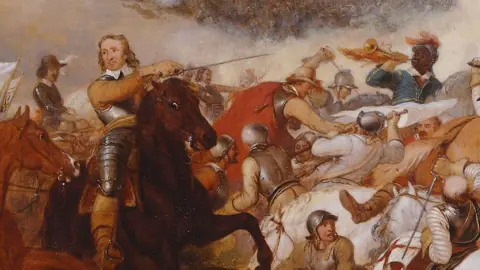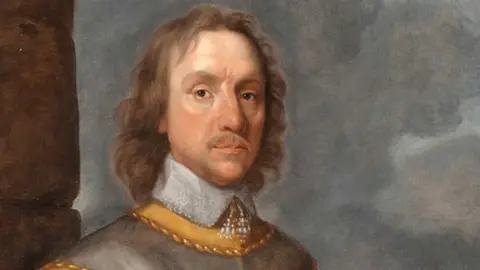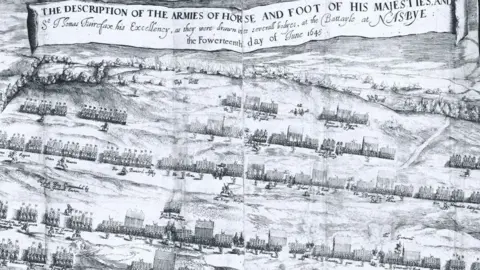'Naseby was the battle that transformed Britain'
 The Cromwell Museum
The Cromwell MuseumA rare 17th Century map showing details of "the battle that transformed Britain" has gone on show at a new exhibition.
The Battle of Naseby, in Northamptonshire, was not only a turning point in the British Civil Wars, but also led to Britain and Ireland being ruled from Westminster for the first time, said curator Stuart Orme.
The forces of Charles I were decisively defeated by Parliament's new uniformed army and the king would be forced to surrender within a year.
The map and other objects associated with the battle have gone on display at the Cromwell Museum in Huntingdon, Cambridgeshire.
 The Cromwell Museum
The Cromwell MuseumThe battle was fought on 14 June 1645. Nearly 25,000 men took part and by midday the king was defeated.
Mr Orme said: "It was every bit as brutal as modern civil wars, including the massacre of about 100 mostly Welsh civilians belonging to the Royalist side by Parliamentary forces in its aftermath."
The fold-out map belonged to a book published in 1647 which charted the victories of Parliament's New Model Army.
 The Cromwell Museum
The Cromwell MuseumMost surviving copies were lost, making it "one of the few contemporary images of a Civil War battle", according to Mr Orme.
"The exhibition includes an animated version of the map, including the real human stories of those who took part," he continued.
They range from Royalist Bridget Rumney, whose mother and sons were massacred by the Parliamentary forces, and Parliamentarian Maj John Francis, who was killed in the battle.
 The Cromwell Museum
The Cromwell MuseumThe discovery of the king's private papers, left behind in the rout, revealed he had been in correspondence with European Roman Catholic countries.
This compounded the Protestant Parliamentarian leaders' distrust of Charles I and ultimately led to his execution.
It was also "the battle that transformed Britain", introducing a standing army which was uniformed in red cloth - the original red coats - and still the dress uniform for the British Army, added Mr Orme.
"We call it the English Civil War but this is the biggest misnomer of history," he said.
"It's something that affected the whole of the country not just England, with Britain and Ireland ruled from Westminster for the first time in the 1650s."
Other objects on display include a 17th Century helmet reputed to have been worn by Oliver Cromwell in the battle, but probably used at his 1658 state funeral, and a carving set made by a local farmer from a sword captured at the battle - the hilt for which was carved as far away as Sri Lanka.
 The Cromwell Museum
The Cromwell MuseumFollow Cambridgeshire news on BBC Sounds, Facebook, Instagram and X.
